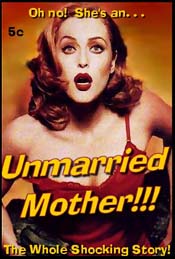
“Out of innocent confusion...
was born heartbreak!” These graphics advertized a 1949 film,
“Not Wanted,” directed and produced by Hollywood star
Ida Lupino. The tragic story featured Sally Forrest (as the unmarried
mother) and Keefe Brasselle. Compare this image to the satirical
image below, which shows a character from the recent TV drama,
“The X-Files.” The contrast illustrates how dramatically
attitudes toward illegitimacy have changed in recent decades.
Before the 1960s, out-of-wedlock pregnancy was such a stigmatized
subject that no one would have poked fun at it in this way. Unmarried
mothers actually were shocking.

|
|
Illegitimacy is not a widely used
word today, and young people may not even recognize it as an insult.
The term designated unmarried mothers, unmarried fathers, and their
unlucky children as deviants. All were called “illegitimate,”
and illegitimate children were sometimes also called “bastards.”
As a label, illegitimacy described their collective status as outcasts
who were legally and socially inferior to members of legitimate
families headed by married couples. Unmarried birth
parents and children suffered penalties ranging from confinement
in isolated maternity homes and dangerous baby
farms to parental rejection and community disapproval. Before
the 1960s, unmarried mothers were usually considered undeserving
of the public benefits offered to impoverished widows and deserted
wives. They were generally denied mothers’ pensions, which
virtually all states granted beginning in 1910, and Aid to Dependent
Children, a federal program created by the Social Security Act of
1935. (Divorced women and non-white women were also excluded.) To
be illegitimate was to be shamed and shunned.
In the nineteenth and early twentieth centuries, the belief that
children born out of wedlock posed significant social and public
health problems was widespread. The U.S.
Children’s Bureau, for example, devoted a great deal of
attention during its early years to combating infant mortality,
and its research and programs in this area focused disproportionately
on illegitimate children and their mothers. Why? These children
were at higher risk than their legitimate counterparts for malnutrition,
mediocre child care, maternal separation, and other hazards. Unmarried
mothers were, by definition, unattached to male breadwinners and
wage work was their only option for economic survival. The unskilled
occupations in which they were concentrated, such as domestic service
and wet-nursing, ironically required them to care for others’
children but made it very difficult for them to raise their own.
Unmarried women and children may have been tainted with sexual immorality,
but those who lived under the shadow of illegitimacy were endangered.
They needed help, according to reformers and policy-makers, who
insisted that alleviating the stigma associated with illegitimate
birth status would do more to improve child
welfare and family life than either contempt or condemnation.
Eugenicists were also dismayed by illegitimacy
because they considered it a major factor in the reproduction of
mental deficiency, disease, and anti-social behavior. According
to their view, “feeble-minded”
children were more likely to be born to unmarried women because
illegitimate pregnancies were byproducts of retardation, insanity,
epilepsy, or other mental defects. It is not surprising, therefore,
that many native-born Americans of European heritage worried that
their own decreasing fertility rates forecast “race suicide”
and viewed child-bearing in other social groups with alarm. New
immigrants, African-Americans, and members of impoverished rural
white communities were implicated in the scandal of illegitimate
births. The fact that poor and minority communities sometimes displayed
greater acceptance of unmarried mothers was sometimes cited as a
reason to deny children in these communities adoption services.
In the case of African-American children,
perceptions of cultural difference in regard to illegitimacy were
compounded by patterns of legal segregation that impacted child
welfare as surely as they did education, housing, employment,
and voting.
The fact that illegitimate white children might be placed for adoption
casually, with barely any regulation or oversight, worried child
welfare reformers during the early twentieth century. Statistical
studies have recently shown that a majority of birth
parents before 1940 were married—which suggests that poverty,
desertion, illness, and other family crises may have been as significant
as illegitimacy in leading to surrender and placement. But many
adopters preferred illegitimate babies and toddlers and went out
of their way to obtain them. They believed that the dishonorable
origins of illegitimate children made it less likely that natal
relatives would ever come back to claim them or interfere in their
lives. Such views led to the charge early in the century that adoption
encouraged illegitimacy. Surrender, critics insisted, allowed unmarried
men and women to avoid the consequences of sexual indulgence: permanent
responsibility for raising and supporting the children they conceived.
But the desperation of many unmarried mothers was impossible to
ignore, and it inspired a curious combination of sympathy and scrutiny.
Reformers who set out to professionalize child
welfare services did not think that adoption was the answer
to illegitimacy. They believed that preserving natal families was
better, even when those families were incomplete, female-headed,
and burdened by disgrace. They promoted state laws, such as the
one passed in Maryland in 1916, which required women to nurse their
babies and prohibited infant placements for a period of six months.
This kind of regulation limited the choices available to unmarried
mothers deliberately. The point was not only to choke off the adoption
black market and reduce other risks involved in placing illegitimate
infants, but to insure that the recipients of public protection
were subjected to moral discipline and behavioral control. The authors
of such laws believed the state’s first priority was to protect
the most vulnerable victims, and illegitimate babies were more vulnerable
than their mothers, even when those mothers were vulnerable to sexual
victimization.
Attitudes changed sharply during and after World War II. The war
years brought increases in illegitimacy, including among married
women whose pregnancies occurred while their husbands were stationed
far away for periods exceeding nine months. After 1945, illegitimacy
was reinterpreted as a sign of individual maladjustment and psychological
disorder, and adoption consequently appeared a positive solution
for many children. Freudian
developmental theory contributed to this transition. Psychoanalysis
reached the peak of its popularity after 1945, sexualizing childhood
and adolescence while stressing the influence of unconscious sexual
desires throughout the entire life course. Earlier in the century,
figures such as Marion Kenworthy, Jessie
Taft, and Viola Bernard
had encouraged social workers, psychiatrists, and other helping
professionals to consider nonmarital pregnancies as expressions
of neurosis. Girls and women who had sex before or outside of marriage
got pregnant on purpose, whether they knew it or not, according
to the Freudian worldview.
As a pathological and invariably unsuccessful attempt to resolve
emotional problems in dysfunctional families of origin, illegitimacy
became the property of psychology and science rather than morality
and religion. By 1950, women could no longer rely on sexual purity
and difference from men as the foundations of their claims to virtue.
It became much harder for women to claim innocence in cases of illegitimate
pregnancy, and that made it much easier to view adoption as a good
thing.
Demographic and cultural trends evident by midcentury also lessened
resistance to separating babies from their unmarried mothers and
boosted the reputation of early adoption. Unmarried mothers after
midcentury were more likely to be white, middle-class adolescents,
and their mortified families were determined to give these wayward
daughters a second chance to find normal love and maternity through
marriage. In the post-Nazi era, the nature-nurture debate swung
decisively toward nurture, and one result was that eugenic anxieties
about the perils of adopting illegitimate infants moved underground.
After the exterminationist regime of National Socialism, which featured
not only death camps but an ambitious sterilization program for
the biologically unfit, talk about defective children and mothers
had such abhorent implications that it became unmentionable, if
not entirely unthinkable. Instead of making them unadoptable, mental
and physical disabilities gave children special
needs. In theory, they qualified for family life even if they
were still unwanted in practice.
Adoption professionals, who had worked so hard to keep natal families
together just a few decades earlier, changed their minds about family
preservation. Between 1940 and 1970, they acted on the belief that
placing children with married, infertile
couples would save them from doomed lives with unmarried, emotionally
unstable mothers who could not offer them real love or security.
Matching practices during this period,
along with confidentiality and sealed
records, reflected the hope that adoption might completely substitute
one family for another, as if from scratch, severing forever the
embarrassing ties between adoptees and their unmarried birth
parents.
All of this changed again after the sexual revolution of the 1950s
and 1960s, and after Roe v. Wade legalized abortion in
1973. During the past three decades, the stigma associated with
out-of-wedlock births—and nonmarital sexuality in general—has
decreased dramatically. Teen pregnancy still causes periodic panic,
but even very young mothers and their babies are no longer ridiculed
as “illegitimates.”
That the meanings of illegitimacy and adoption could undergo such
drastic change suggests a broader revolution in modern American
thought and culture. During the second half of the twentieth century,
fixed and singular standards of conduct gave way under the pressure
of social and intellectual movements that championed pluralism and
diversity. In an age of civil rights, democracy required new tolerance
for a wide spectrum of values. In spite of the powerful resurgence
of religious fundamentalism and social conservatism in public life
since the 1960s, there is no longer “one right way”
to live, love, or bring families into being in the United States. |



